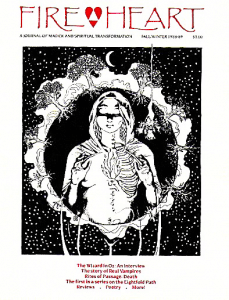 THE EIGHTFOLD PATH
THE EIGHTFOLD PATH
Part One: MEDITATION
by Walter Wright Arthen ©1988
To support himself, Nasrudin took a job rowing a ferry across a particularly dangerous river.
One day a famous grammarian came to him for help across the river.
The water was higher and more dangerous than usual.
“T’ain’t been this bad since before I ever was here abouts!” said the Mullah.
The grammarian bristled at Nasrudin’s bad speech. “My good man, have you never learned grammar? Half of your life has been wasted!”
A little later Nasrudin asked his passenger, “C’n you swim?”
“No. Why?”
“Because all of your life has been wasted! The boat is sinking.”
Meditation, whatever we may call it, is a basic human spiritual practice. “Going within” opens a doorway from mundane reality into other realms. But this apparently simple act can assume a remarkable number of forms. The medieval Christian monk knew it as “orison”, sustained and intense prayer. And whether it takes the shape of sufi dhikr, zazen-the intricate visions of Tibetan Buddhism, or “Central Pillar” cabalist pathworking, meditation is found everywhere. It may be with form or formless; it may be seated or in movement; it may be silent or involve such things as chanting or drumming. The common thread which makes these all forms of meditation is that each aims at weakening ordinary reality’s hold while opening the mind and heart to subtler influences.
Meditation begins with stilling the senses. The bonds that bind us to the outer world are weakened. This may be done in several ways. Deep physical relaxation, stilling the breath, or focusing the mind on a single object will all loosen the threads of intention and desire which hold the world in place. But slow rhythmic movement, chanting, and even boredom will produce similar effects.
We can distinguish two distinct types of meditation: the receptive and the active. In receptive meditation, the meditator remains in the quiet center, allowing relaxation to work progressively more deeply. As the mind stills and empties, one merges with the silence of Being, This kind of meditation is directionless opening-it is “just sitting.” Here the meditator lets go of everything, including self, and enters the flow of what occurs. Practicing in this way calls for patience, a release of personal will, and the steady return of the mind to stillness. States of ecstasy or insight may come, but they too are simply part of the flow to be noted and released. All internal identifications or attachments, whatever their content, are to be released. Receptive meditation of this type is very familiar from the great Asian spiritual traditions; but, while some in our community may know of or pursue such practices, receptive meditation plays a smaller role in the Craft than do other types.
We can understand the dominance of more active kinds of meditation in Witchcraft if we think about the energies that are involved. As humans, we inhabit a world of energies that work on several levels. Some energies are subject to our direct control. So, for example, the physical energies in material objects can be manipulated and directed to our purposes. The powers of technological reason to control the natural world are continually expanding without forseeable limit. A second group of energies can be worked with only in a cooperative way. While we can dance with them, they are not entirely controllable. We understand them, direct them as we can, and yield to them as we must. The interactive energies of the social world are of this kind. A third group of energies may be recognized, and sometimes even partially understood, but they cannot really be controlled. One can only submit to them. The creative and unitive energies that touch us at rare moments exemplify this group. When a person at the peak even seems to control these powers, this is really a measure of that individual’s submission. The great spiritual gestures in human history (the martyrdom of Hallaj, the crucifixion of Jesus of Nazareth, or the prophecies of Black Elk) provide evidence of this.
Different meditative practices work with different classes of energy. Receptive meditation works exclusively with the second and third kinds of energy, but primarily with the third. At the outset, the beginning meditator must let go of the normal waking state with its attitude of manipulation and control toward the surrounding world. Only as this basic stance is relaxed can any other, deeper connections with what there is begin to form. For this reason, receptive meditation is often a first step in learning techniques of inner work. But the full path of receptive meditation does not stop with this initial relaxation. Instead, it continues to open the meditator to the higher energies, dissolving all structures and objects of thought, including personal individuality. Its outcome is an indissolvable union of the meditator with the higher powers.
Witchcraft as a spiritual path emphasizes active meditation. It does not aim at the dissolution of the self into the higher powers. It does not seek the union of “Atman” with “Brahman”. The Craft aims instead at developing a sensitive partnership between the Witch and these hidden forces. For us, meditation is tool which forges a link between individual will and the forces of nature. Since life is good in all of its aspects, individual existence is not something to be denied or transcended. individual existence is rather the medium in which we and the world work out our common destiny In the Craft, meditation begins with relaxation, attention to breathing, and stillness; but these techniques are only preliminary. Rather than simply opening to the inner realms, Craft meditation involves actively working to shape the astral energies in particular ways. Such meditation usually takes the form of inner journeying, pathworking, channeling of energies and/or entities, and other similar work.
The fundamental techniques underlying all these actions is visualization. When Witches meditate. we create imagined, visualized forms which can serve as the vehicles for the transmission of subtle energies. So, for example, at a seasonal ritual, we may use meditative visualization to create imaginal forms which carry the energy of the season. At Oimelc we may envision a spark of light growing in the darkness as the seed of the coming warmth. We do this to help ourselves identify with the hidden tidal changes at work in nature. At another time, we may visualize ourselves as trees with roots seeking down into the earth, and branches rising toward the sun. This image builds our connection with the unity of life on the inner planes. We work with it as part of our human duty to be transformers of energy within the system of mutually dependent energy exchanges which is life on earth. As part of a healing circle, we may visualize the person being worked on as whole and healthy. Active meditation uses visualization as its primary tool, and the “astral” images it creates become the medium through which subtle energy is raised and directed.
While active meditation and receptive meditation are quite distinct in form, they do not necessarily differ in their ultimate aims. Both kinds of meditation are directed toward producing a balanced harmony between the individual and the whole. Receptive meditation works directly for this outcome by submitting the meditator to the action of the higher powers; but active meditation uses the will and individuality of the meditator to shape astral energies into a vehicle for achieving the same balance. Each approach has its special dangers. Receptive meditation can make the meditator too passive. To be a human is to be an agent. If one simply submits, one risks losing one’s distinctive humanity. On the other hand, active meditation can get out of balance if one forgets that there are higher forces and that these forces have their own pattern of activity which is beyond our direct control. Then one may forget the inevitable limits of human activity and go on dangerous “power trips” or get lost in fantasy.
As Nasrudin said to the proud scholar who could not swim, “All your life has been wasted. We’re sinking!” Meditation in all of its forms is learning how to swim. The finer energies around us are potent and real. The essence of training in Witchcraft is learning how to live and work consciously within that subtle environment which ordinarily most people simply ignore. Meditation is one step in that training. It opens the Witch to the reality of these finer energies, shows something of their dynamics, and gives the trainee techniques for working with them. For that reason, it is the first step on the Eightfold Path. In our next issue, we will turn to chanting as a tool in the Craft.
WALTER WRIGHT ARTHEN co-editor of FireHeart and a memberof the Board of Directors of the EarthSpirit Community. He is a frequent contributor to FireHeart. His writing blends wide experience with many spiritual paths and a commitment to building bridges betueen the Pagan community and secular culture.
